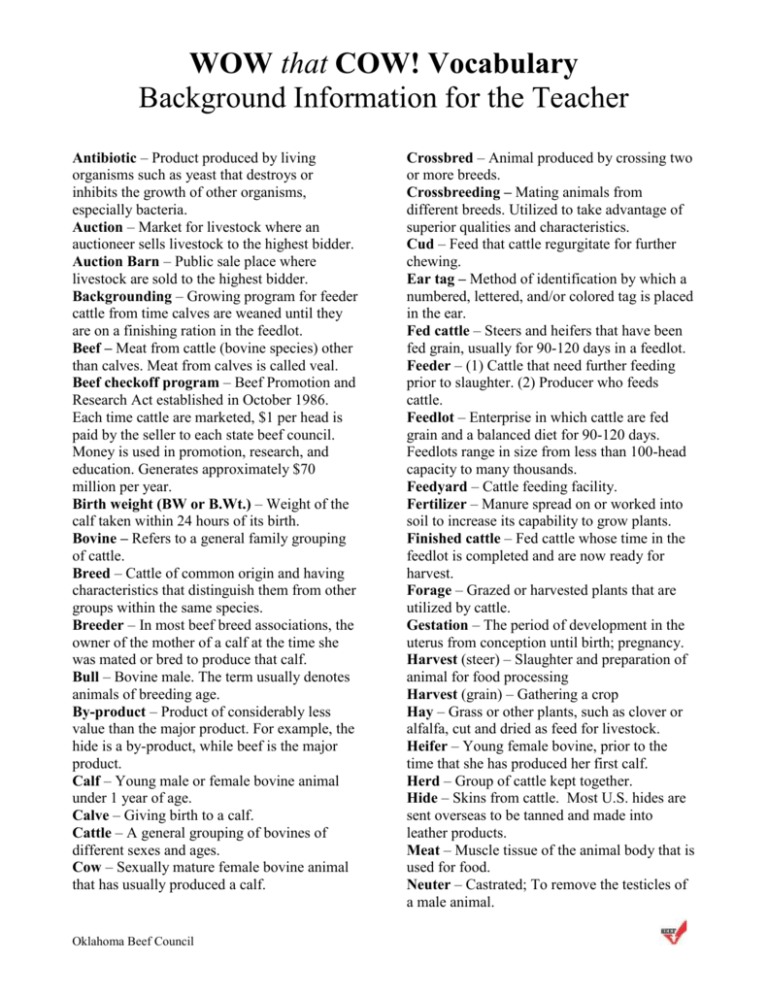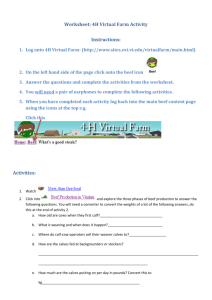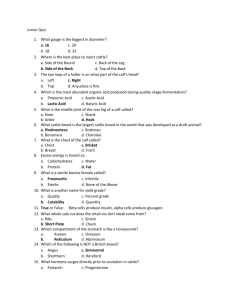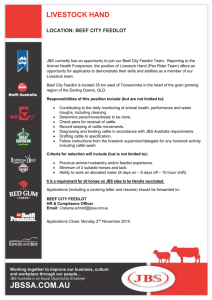Background Information for the Teacher
advertisement

WOW that COW! Vocabulary Background Information for the Teacher Antibiotic – Product produced by living organisms such as yeast that destroys or inhibits the growth of other organisms, especially bacteria. Auction – Market for livestock where an auctioneer sells livestock to the highest bidder. Auction Barn – Public sale place where livestock are sold to the highest bidder. Backgrounding – Growing program for feeder cattle from time calves are weaned until they are on a finishing ration in the feedlot. Beef – Meat from cattle (bovine species) other than calves. Meat from calves is called veal. Beef checkoff program – Beef Promotion and Research Act established in October 1986. Each time cattle are marketed, $1 per head is paid by the seller to each state beef council. Money is used in promotion, research, and education. Generates approximately $70 million per year. Birth weight (BW or B.Wt.) – Weight of the calf taken within 24 hours of its birth. Bovine – Refers to a general family grouping of cattle. Breed – Cattle of common origin and having characteristics that distinguish them from other groups within the same species. Breeder – In most beef breed associations, the owner of the mother of a calf at the time she was mated or bred to produce that calf. Bull – Bovine male. The term usually denotes animals of breeding age. By-product – Product of considerably less value than the major product. For example, the hide is a by-product, while beef is the major product. Calf – Young male or female bovine animal under 1 year of age. Calve – Giving birth to a calf. Cattle – A general grouping of bovines of different sexes and ages. Cow – Sexually mature female bovine animal that has usually produced a calf. Oklahoma Beef Council Crossbred – Animal produced by crossing two or more breeds. Crossbreeding – Mating animals from different breeds. Utilized to take advantage of superior qualities and characteristics. Cud – Feed that cattle regurgitate for further chewing. Ear tag – Method of identification by which a numbered, lettered, and/or colored tag is placed in the ear. Fed cattle – Steers and heifers that have been fed grain, usually for 90-120 days in a feedlot. Feeder – (1) Cattle that need further feeding prior to slaughter. (2) Producer who feeds cattle. Feedlot – Enterprise in which cattle are fed grain and a balanced diet for 90-120 days. Feedlots range in size from less than 100-head capacity to many thousands. Feedyard – Cattle feeding facility. Fertilizer – Manure spread on or worked into soil to increase its capability to grow plants. Finished cattle – Fed cattle whose time in the feedlot is completed and are now ready for harvest. Forage – Grazed or harvested plants that are utilized by cattle. Gestation – The period of development in the uterus from conception until birth; pregnancy. Harvest (steer) – Slaughter and preparation of animal for food processing Harvest (grain) – Gathering a crop Hay – Grass or other plants, such as clover or alfalfa, cut and dried as feed for livestock. Heifer – Young female bovine, prior to the time that she has produced her first calf. Herd – Group of cattle kept together. Hide – Skins from cattle. Most U.S. hides are sent overseas to be tanned and made into leather products. Meat – Muscle tissue of the animal body that is used for food. Neuter – Castrated; To remove the testicles of a male animal. WOW that COW! Vocabulary Background Information for the Teacher Pasture rotation – Rotation of animals from one pasture to another so that some pasture areas have no livestock grazing on them during certain periods of time. This allows for continuous growth of grass. Ration – A balanced diet that allows animal to produce muscle. Renewable Resources – An available, replaceable source that can be drawn on when needed. Roughage – Feed that is high in fiber, low in digestible nutrients, and low in energy (e.g., hay, straw, silage, and pasture). Rumen – A compartment of the ruminant stomach that is similar to a large fermentation pouch where bacteria and protozoa break down fibrous plant material swallowed by the animal. Sometimes referred to as the paunch. Ruminant – Mammal whose stomach has four parts—rumen, reticulum, omasum, and abomasum. Cattle, sheep, goats, deer, and elk are ruminants. Silage – Forage, corn fodder, or sorghum preserved by fermentation that produces acids similar to the acids used to make pickled foods for people. The whole (corn) plant is chopped up while green. Steer – Bovine male castrated prior to puberty. Udder – Group of mammary glands of the female, which produce the milk for the calf. Weaning (wean) – Separating young animals from their mothers so that the offspring can no longer suckle. Oklahoma Beef Council








